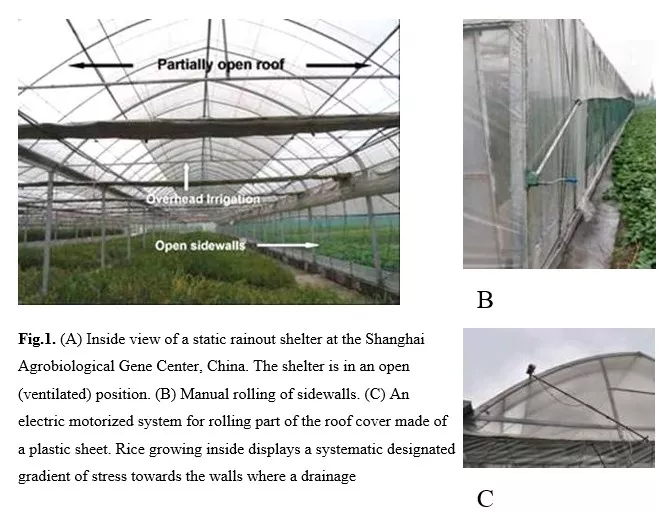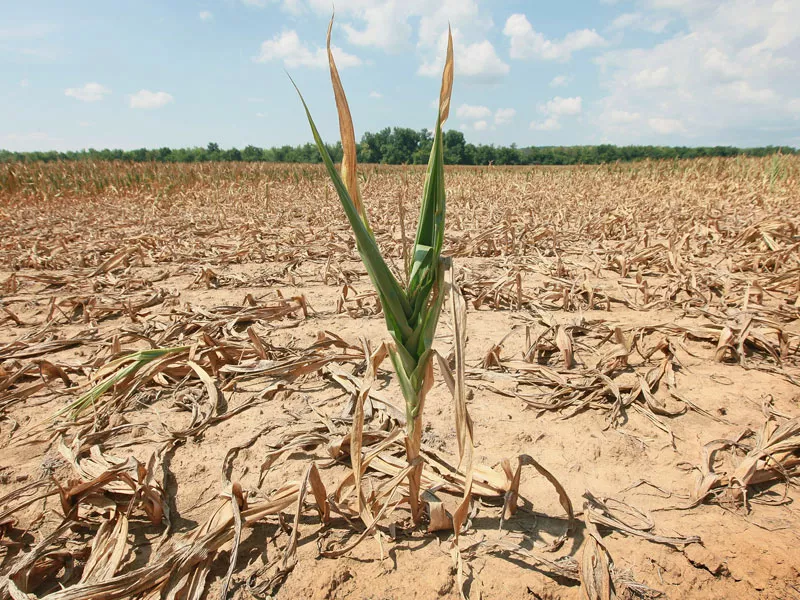Rainout Shelters: Some Basic Principles of Design and Operation
By A. Blum
Rainout shelters are designed to protect a certain area of land against receiving precipitations so that an experimentally controlled drought stress can be imposed on that area. Many types of rainout shelters were designed and used, with better or lesser results. This is not a comprehensive review of this system but a concise discussion of the most important issues in designing, constructing and operating rainout shelters.
There are two main designs: (1) static and (2) movable. Within the moveable design there are automatic/motorized and manual versions. The automatic version is signaled to move over the protected plot by a rain sensor and an electric drive system. The manual version is moved either by manually switching the drive on (“manually driven”) or by manually pushing it (“manually pushed”) over the protected plot. The ‘manually pushed’ must by lightweight and hence it is cheaper and can cover a limited land area. The automatic version is becoming less popular because of reliability problems and cost. Hence, many automatic types become ‘manually driven’ after the first failure of the automatic system. The earlier automatic shelters were designed without any consideration for light transmission because they were not expected to remain over the protected plot for a long time.
The manual version is moved from its parking spot onto the protected plot whenever a rain is expected and not when the rain begins. It is moved into the parking space whenever rain is expected to cease completely. Good weather forecasting service is therefore important. If forecasting is unreliable, better have the shelter over the protected plot more time than expected. Therefore, the shelter construction must allow sufficient light inside as well as some ventilation.
The direction of the protected plot and the parking place of the shelter should be designed so that the parked shelter will not shade the plot in the morning or the evening and that the direction of the wind would not allow rain to blow under the shelter. The shelter parking place cannot be used for growing experimental plots.

Automatic rainout shelter at UGA Griffin Station turfgrass research, used to protect experiments performed in containers. However, the shelter is very dim.
The area around the shelter should be managed in consideration of surface runoff and the drainage and diversion of rainfall flowing off the shelter especially under storm conditions. Hence ditches and other means of protection should be properly placed around the installation, with respect to topography. Consideration should be given also to the fact that horizontal flow of water in a saturated soil can be appreciable.
Often experiments under a rainout shelter involve control (non-stressed) plots. If the protected plot is not covered by the shelter for an extensive period of time, than the control plots may be placed outside the shelter and exposed to rainfall (or irrigation). However, if a perfectly controlled experiment is planned, then the control plots should be placed also under the shelter and irrigated. Drip or manual irrigation is a good way to assure proper separation between control and stress plot treatments. The two treatments should constitute separate blocks under the shelter. Experiments were also performed by using containers (pots or large vessels such as PVC tubes for root studies) placed under a rainout shelter. Rainout shelters provide an environment which is much closer to the ambient than a standard greenhouse.
THE STATIONARY RAINOUT SHELTER
This type of shelter is actually a well ventilated greenhouse that can be quickly rain-proofed or ventilated, on and off, at will (Fig.1A). The principle is that when it is not closed for rain exclusion in must be well ventilated to equilibrate with the external ambient conditions. Since it is permanently covered by a (transparent) roof, the water regime inside must be regulated by irrigation. Control (non-stress) plots are grown inside the shelter and are fully irrigated. Both the walls and part of the roof can be widely opened for ventilation when there is no rain. Irrigation can be provided by overhead sprinklers or by drip irrigation. Consider the possibility that drip irrigation might result in a different root system as compared with that under other irrigation methods which supply larger quantities of water in shorter time periods, similar to rain. Some drip irrigation systems can be programmed to deliver larger than normal quantities of water per unit time.









